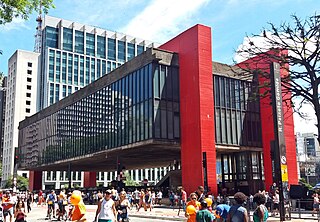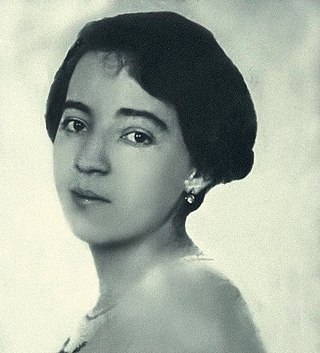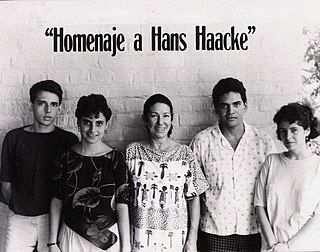Related Research Articles

The São Paulo Museum of Art is an art museum located on Paulista Avenue in the city of São Paulo, Brazil. It is well known for its headquarters, a 1968 concrete and glass structure designed by Lina Bo Bardi, whose main body is supported by two lateral beams over a 74 metres (243 ft) freestanding space. It is considered a landmark of the city and a main symbol of modern Brazilian architecture.

Anita Catarina Malfatti is heralded as the first Brazilian artist to introduce European and American forms of Modernism to Brazil. Her solo exhibition in Sao Paulo, from 1917–1918, was controversial at the time, and her expressionist style and subject were revolutionary for the complacently old-fashioned art expectations of Brazilians who were searching for a national identity in art, but who were not prepared for the influences Malfatti would bring to the country. Malfatti's presence was also highly felt during the Week of Modern Art in 1922, where she and the Group of Five made huge revolutionary changes in the structure and response to modern art in Brazil.

Pedro Friedeberg is a Mexican artist and designer known for his surrealist work filled with lines colors and ancient and religious symbols. His best known piece is the “Hand-Chair” a sculpture/chair designed for people to sit on the palm, using the fingers as back and arm rests. Friedeberg began studying as an architect but did not complete his studies as he began to draw designs against the conventional forms of the 1950s and even completely implausible ones such as houses with artichoke roofs. However, his work caught the attention of artist Mathias Goeritz who encouraged him to continue as an artist. Friedeberg became part of a group of surrealist artists in Mexico which included Leonora Carrington and Alice Rahon, who were irreverent, rejecting the social and political art which was dominant at the time. Friedeberg has had a lifelong reputation for being eccentric, and states that art is dead because nothing new is being produced.

Victor Meirelles de Lima was a Brazilian painter and teacher who is best known for his works relating to his nation's culture and history. From humble origins, his talent was soon recognized, being admitted as a student at the Imperial Academy of Fine Arts. He specialized in the genre of history painting, and upon winning the Academy's Foreign Travel Award, he spent several years training in Europe. There he painted his best-known work, Primeira Missa no Brasil. Returning to Brazil, he became one of emperor Pedro II's favorite painters, joining the monarch's patronage program and aligning himself with his proposal to renew the image of Brazil through the creation of visual symbols of its history.

The National Museum of Contemporary Art of Chiado is an art museum located in the Chiado neighbourhood of Lisbon, Portugal. It was created in 1911 and re-inaugurated, in new installations, in 1994.

The Museu Nacional de Belas Artes is a national art museum located in the city of Rio de Janeiro, Brazil. The museum, officially established in 1937 by the initiative of education minister Gustavo Capanema, was inaugurated in 1938 by President Getúlio Vargas. The museum collection, on the other hand, takes its rise in the transfer of the Portuguese Court to Brazil in the early 19th century, when King John VI brought along with him part of the Portuguese Royal Collection. This art collection stayed in Brazil after the King's return to Europe and became the core collection of the National School of Fine Arts. When the museum was created in 1937, it became the heir not only the National School collection, but also of its headquarters, a 1908 eclectic style building projected by Spanish architect Adolfo Morales de los Ríos.

The creation of art in the geographic area now known as Brazil begins with the earliest records of its human habitation. The original inhabitants of the land, pre-Columbian Indigenous or Natives peoples, produced various forms of art; specific cultures like the Marajoara left sophisticated painted pottery. This area was colonized by Portugal in the 16th century and given the modern name of Brazil. Brazilian art is most commonly used as an umbrella term for art created in this region post Portuguese colonization.

Pedro Américo de Figueiredo e Melo was a Brazilian novelist, poet, scientist, art theorist, essayist, philosopher, politician and professor, but is best remembered as one of the most important academic painters in Brazil, leaving works of national impact. From an early age he showed an inclination towards the arts, being considered a child prodigy. At a very young age, he participated as a draftsman on an expedition of naturalists through the Brazilian northeast, and received government support to study at the Imperial Academy of Fine Arts. He did his artistic improvement in Paris, studying with famous painters, but he also dedicated himself to science and philosophy. Soon after his return to Brazil, he began to teach at the Academy and began a successful career, gaining prominence with great paintings of a civic and heroic character, inserting himself in the civilizing and modernizing program of the country fostered by emperor Pedro II, of which the Imperial Academy was the regulatory and executive arm in the artistic sphere.

Pedro Cabrita Reis is one of the foremost visual artists of his generation and also one of Portugal’s most internationally renowned artists. His work features a wide variety of media – painting, sculpture, photography and drawing – and has been exhibited and included in numerous national and international museum collections. He lives and works in Lisbon.

Grupo ABTV was the name given to the artistic collaboration between Cuban artists Tanya Angulo (1968), Juan Ballester Carmenates (1966), José Toirac (1966) and Ileana Villazón (1969) by the Uruguayan artist and critic Luis Camnitzer.
Sofia Areal is a Portuguese abstract painter, whose works adhere mostly to organic non-geometrical forms and a strong chromatic focus. Besides painting and drawing, Areal's work involves collage, textile design, and scenography.

Jorge Barreto Xavier is a Portuguese cultural manager, university professor and politician. He was, between October 2012 and October 2015, the Secretary of State for Culture of the XIX Constitutional Government of Portugal, under the authority of the Prime-Minister, Pedro Passos Coelho.

The Imperial Academy of Fine Arts was an institution of higher learning in the arts in Rio de Janeiro, Brazil, established by King João VI. Despite facing many initial difficulties, the Academy was established and took its place at the forefront of Brazilian arts education in the second half of the nineteenth century. The Academy became the center of the diffusion of new aesthetic trends and the teaching of modern artistic techniques. It eventually became one of the principal arts institutions under the patronage of Emperor Dom Pedro II. With the Proclamation of the Republic, it became known as the National School of Fine Arts. It became extinct as an independent institution in 1931, when it was absorbed by the Federal University of Rio de Janeiro (UFRJ) and became known as the UFRJ School of Fine Arts, which still operates today.

The Museum of Modern Art of Bahia is a modern art museum located in Salvador, Bahia, Brazil. It is located within Solar do Unhão, a historical site dating to the 16th century, on the margin of the Bay of All Saints. The museum was founded in 1960 under the architect Lina Bo Bardi (1914-1992) and initially located in the foyer of the Castro Alves Theater; it moved to its present location in 1963. MAM-BA is one of twelve state museums linked to the Institute of Artistic and Cultural Heritage (IPAC), an authority of the Department of Culture of the State of Bahia.

The Landing of Pedro Álvares Cabral in Porto Seguro in 1500 is an oil painting by the Brazilian artist Oscar Pereira da Silva. The work, which was completed in 1900, depicts the first landing of Pedro Álvares Cabral's ships in 1500 on the land of present-day Brazil and the first meeting between Portuguese and indigenous Brazilian people. It established Oscar Pereira da Silva (1867-1939) as a prominent painter on the Brazilian artistic scene of the early 20th century. Pereira da Silva's painting is one of the most-referenced images of Pedro Álvares Cabral's arrival in Brazil, and is widely used in both textbooks and other academic publications. The painting was well received by society and the press of the time; its representation of indigenous Brazilians has been subsequently reexamined.

Augusto Barros Ferreira, better known as Augusto Barros, and simply Barros, is a Portuguese painter born on August 7, 1929, in Lisbon (Portugal), and dead on February 10, 1998, in Lisbon. Abstractionist painter, and emblematic figure of the Parisian district of Saint-Germain-des-Prés of the 1970s.
Jaider Esbell was a Brazilian writer, artist, art educator, curator, geographer, and indigenous rights activist.

Graça MoraisGOIH is a Portuguese artist. A member of the Academia Nacional de Belas-Artes of Portugal, she was made a Grand Officer of the Order of Prince Henry in 1997. She is married to the musician Pedro Caldeira Cabral.

Brazilian Romantic painting was the main expression of the plastic arts in Brazil in the second half of the 19th century. This pictorial production was part of the local evolution of the Romantic movement and approximately coincided with the period of the Second Reign, but its characteristics were unique, differing in several points in relation to the original version of European Romanticism and likewise cannot be considered an exact parallel to the manifestation of Romanticism in Brazilian literature of the same period. It had a palatial and restrained aspect, brought a strong neoclassical influence and soon blended with Realism, Symbolism and other schools, in an eclectic synthesis that prevailed until the early years of the 20th century.
Tikashi Fukushima was a Japanese-Brazilian painter and printmaker. Considered one of the most important abstractionists in Brazil, Fukushima also produced several works in the field of figurativism throughout his career. The artist has received various positive reviews from numerous important art critics for both his abstractionist and figurative productions. Fukushima belongs to the pre-war immigrant generation, composed of common immigrants who, after several changes in their lives, awakened to the arts. His master was Tadashi Kaminagai, whom Fukushima saw as a mentor, but who had a different style of painting than the one he later developed. Tikashi's works have been presented in national and international exhibitions.
References
- ↑ "Pedro Portugal - Eu Explico". Arte Capital.net.
- ↑ Melo, Alexandre (2007). Arte e artistas em Portugal. Bertrand.